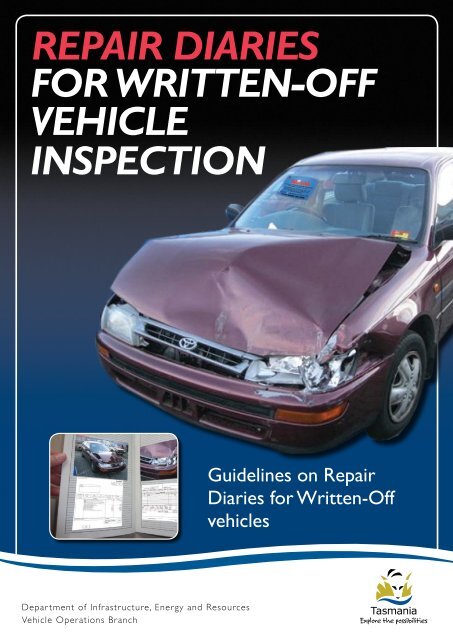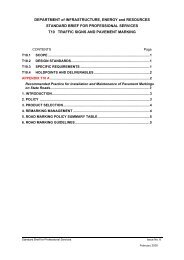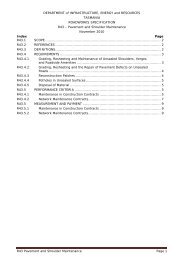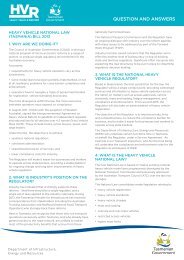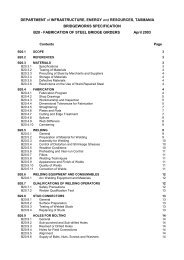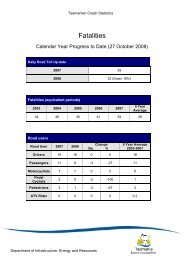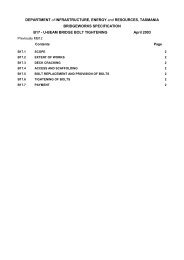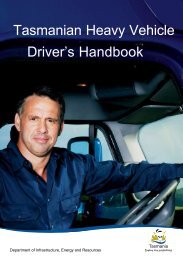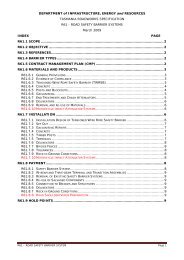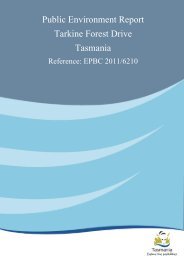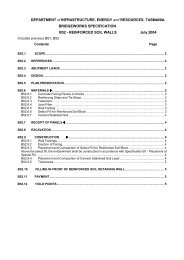Repair Diary Brochure - Transport
Repair Diary Brochure - Transport
Repair Diary Brochure - Transport
- No tags were found...
You also want an ePaper? Increase the reach of your titles
YUMPU automatically turns print PDFs into web optimized ePapers that Google loves.
REPAIR DIARIESFOR WRITTEN-OFFVEHICLEINSPECTIONGuidelines on <strong>Repair</strong>Diaries for Written-OffvehiclesDepartment of Infrastructure, Energy and ResourcesVehicle Operations Branch
As of 1 July 2012 it is strongly recommendedthat a repair diary is presented for ALL<strong>Repair</strong>able Write Off (RWO) vehicles that havebeen classified as a RWO after 1 July 2012when presenting the vehicle for its tier 1 and3 inspection in Tasmania. Failure to present arepair diary after this date could well result inthe vehicle being failed for inspection.Note: This fact sheet should be read in conjunctionwith the fact sheet on “What you need to do beforeyou purchase a written-off vehicle”.Manufacturer’s guidelinesA damaged vehicle must be repaired in accordance with themanufacturer’s repair instructions, or if unavailable, best industrypractice.The repairer is responsible for obtaining the manufacturer’sguidelines from the vehicle manufacturer or an authoriseddealer of the manufacturer prior to repairing the vehicle.To assist, technical information can be sourced frommanufacturers detailed at the end of this fact sheet.Note: Manufacturers may charge for this material.In some rare cases, a manufacturer will not issue the guidelinesand refer you to an authorised repairer of that vehicle make.In these cases the vehicle should be repaired at an authorisedrepairer as some manufacturers require specialist equipment andknowledge to conduct the repairs.Not all damaged vehicles can be repaired easily or economically.The fact that the vehicle is entered on the Written Off VehicleRegister (WOVR) as a RWO is an indication that the cost torepair the vehicle was greater than the market value of thevehicle and too expensive to repair at commercial rates and toguarantee an ongoing warranty.It is important for a potential buyer of a damaged vehicle tounderstand the risks associated with buying a damaged vehicle,as the scope of repairs may expand quickly beyond the intendedbudget to repair the vehicle, and many unknown factors maycome to light during the repair or inspection process which maylead to the vehicle costing more to repair than was estimated.Risks of not complying with manufacturers’guidelines or best industry practiceIf you repair a vehicle without the guidelines or to best industrypractice, you run the risk of the vehicle being incorrectly repairedand its structural integrity being compromised. This may resultin the area of repair being significantly weaker or stronger thanoriginally intended by the manufacturer, leading to the crashworthinessof the vehicle being compromised and potentiallycatastrophic results if the vehicle is involved in an accident.In this case you will encounter difficulty and additional costsat the time of a structural inspection, and the vehicle will notpass the inspection until the vehicle is correctly repaired andsatisfactory evidence of this is provided.<strong>Repair</strong>ing a damaged vehicleKeeping a crash repair diaryA crash repair diary is a detailed record explaining what repairswere needed on the vehicle, what repair techniques werereferenced and how they were applied during the repair. It alsocontains progress photographs and other material to provideevidence of the nature, extent and activities of the vehicle repair.The diary can be in any form and should chronologically followthe vehicle from purchase, through all repair stages, and end atthe point of presentation for inspection.An example of a crash repair diary is located on the Departmentof Infr astr ucture Ener gy and Resources (DIER) website on:http://www.transport.tas.gov.au/vehicle_ inspections/ambrisPhotographsWhen taking photos, it is best to take a number of photos toensure you describe the process properly. When dismantling avehicle, take photos, when components are being fitted or beingrepaired and refitted, take photos.Photos from the auction house prior to sale are required. Thesemust be obtained as hard copy from the auction house, notdownloaded electronically.Depending on the repair area, and how close the photo is taken, itmay be difficult in interpreting what part of the vehicle the photois showing. In these cases it is best to take a photo from a mediumdistance, and then a close up. Sometimes it helps when scale isintroduced to the photo, so a tape measure can be picturedagainst the subject area to assist.When compiling the crash repair diary, each step should bedocumented with photos and cross referenced with the relevantarea from the manufacturer’s guidelines. A recommended outlineof the crash repair diary should contain a detailed description andphotos:• Before repair work;• During jigging;• Removed panels and pieces;• Replacement panels and pieces;• Method of attachment of replacement panels and pieces; and• Specialised equipment used in the repair.Keeping a crash repair diary when repairing a vehicle createsvisibility of the repair process and you will be less likely to encounterdifficulty when presenting the vehicle for a structural inspection(Tier 1) and WOVR inspection (Tier 3). If the crash repair diary isdone correctly, you may reduce the likelihood of the vehicle beingfailed for inspection or requested to undergo further inspections.Note: The repair diary should be presented in hard copy for itsstructural and WOVR inspections. An electronic copy must also beprovided for the structural inspection, this will be downloaded andforwarded to DIER.What happens if I do not produce arepair diary when presenting my vehiclefor inspection?It is acknowledged that Motor Body Examiner (MBE) cannoteasily be satisfied that the repairs carried out have beenrepaired to the manufacturer’s repair instructions or bestindustry practice, and is justified in failing the vehicle forinspection where they cannot be satisfied as such.
Supplementary Restraint System(SRS) ReportsSRS reports (AMBRIS5) are required for• All water immersed vehicles;• Any SRS systems has deployed as a result of impact damage; or• The SRS system has been compromised/disconnected due tothe nature of repairs carried out. E.g. Removal of seats/dashassemblies.In the event that the MBE fails the vehicle the owner will haveto produce evidence ( that would have otherwise been presentin the repair diary) that the vehicle has been repaired tomanufacturer’s repair instructions or best industry practice tothe Registrar of Motor Vehicles (RMV) and satisfy the RMV thatthis has occurred.It is recognised that this will cause a time delay, due to the RMVhaving to investigate and gather evidence after the vehicle hasbeen repaired rather than during the repair process.Fire affected vehiclesGenerally, a fire damaged vehicle will usually be assessed as aStatutory Write-Off. In the case where the fire damage is minorand the vehicle is assessed as a repairable write-off, the firedamaged components must be replaced. It should be understoodthat the heat in the incident may not be limited to theimmediate fire area, and have affected other components in thevehicle, especially high strength light alloy steels in key structuralcomponents. <strong>Repair</strong>ing such a vehicle may facilitate replacementof major components that have been heat affected, and maybecome more costly than estimated.If using components from a fire damaged vehicle torepair another vehicle, you should exercise caution to ensureyou do not utilise heat affected components. Doing so maycompromise the structural integrity of the vehicle. Photographicevidence of the donor car (in this case the fire damagedvehicle) should be supplied to verify the extent of damage tothe vehicle. You may then be required to obtain a report from ametallurgist experienced in modern steels stating the fire-affectedcomponents have not been adversely affected by heat.Water damaged vehiclesA vehicle immersed in fresh water that has been classified as aRWO will require a water immersion report (AMBRIS6)*The water immersion report is not a simple check. The cost toobtain this report should be noted, as there is a significant labourcomponent for a dealer of the manufacturer to undertake thiswork. If contamination is identified, this will result in further costsin replacing the affected componentsThe report specifies that it represents an inspection of thesystem on the date it is issued. The vehicle has been waterimmersed and this report is not a guarantee that future issueswill not arise from the vehicle being water immersed.A vehicle immersed in salt water for any period above thedoorsill level or, for a motorcycle, is fully immersed in salt water,is considered to be a Statutory Write-Off and is not eligible forregistration in Tasmania.If a vehicle has been damaged by fresh/salt water and/or any SRSsystem has deployed and is assessed as a repairable write-off, aspart of the structural inspection you will be required to obtain a(SRS)/Electronic Control Unit (ECU) report from an authorizeddealer of the manufacturer. * #This report certifies that the ECU has been checked forcontamination and / or replaced and all wiring links havebeen checked for contamination. The manufacturers’ agent isrequired to confirm that all integrated circuitry (ABS, TractionControl, Stability Control etc) are not compromised and theSRS components (e.g. air bags and any seat belt pre-tensioners)are not contaminated and are still serviceable.If the ECU or other components are found to be contaminated,the dealer may require a replacement ECU to be fitted beforethe report is issued. A new or second hand ECU may be used.However, if utilising a second hand ECU the component mustnot be refurbished from another water damaged vehicle, anddonor VIN details are required to be provided to the MotorBody Examiner (MBE).The SRS report is not a simple SRS diagnostic check. The costto obtain this report should be noted, as there is a significantlabour component for a dealer of the manufacturer to undertakethis work. If contamination is identified, this will result infurther costs in replacing the affected components.You must obtain the report prior to the structural Inspection,provided the AMBRIS5 report is fully completed and stamped byan authorised dealer of the manufacturer, and is accompanied bya tax invoice. This invoice is to detail all checks carried out andany parts replaced.While the vehicle may function correctly on the day of thestructural inspection and when the SRS report is obtained, itcannot be guaranteed the vehicle will remain serviceable infuture. It is the responsibility of the owner/operator to ensurethe ongoing roadworthiness of the vehicle.Vandalised/cosmetically damaged vehiclesOn occasion, a vehicle may be entered on the WOVR as arepairable write-off and bear only cosmetic damage which doesnot compromise the vehicle’s crashworthiness or vehicle safetysystems.DIER requires that the damage which caused the vehicleto be entered on the WOVR as a repairable write-off,should be repaired, restored or replaced. Accordingly,cosmetically damaged vehicles (for example a motorcycle withscratched fairing or a vehicle with paint/hail damage) do not haveto be repaired unless it has been determined that it constitutes adangerous protrusion or it has affected the structural integrity ofthe vehicle.This requirement is consistent with the objectives of theNational Written-Off Vehicle Guidelines, and applies to alldamage categories including Hail/Storm damage.# AMBRIS5 SRS report required * AMBRIS6 Water immersion report required
Hail damaged vehiclesVehicles that have been damaged by hail due to storm eventsdo not have to be repaired unless it has been determined thatit constitutes a dangerous protrusion or it has affected thestructural integrity of the vehicle.Invoices – tax requirementsWhen engaging a repairer to repair a vehicle, it is required thata valid tax invoice, as prescribed by the Australian Tax Office,is issued for the parts and/or labour to repair the vehicle. Thisinvoice must clearly identify the vehicle repaired, all the repairscarried out, and all parts used in the repair of the vehicle.You are required to retain and present all relevant tax invoicesat the time of the Tier 3 inspection to verify the legitimacyof the repair. In the case of a self repair, all the same requirementsmust be met, but a repair statement can be used.Remember to include invoices for all repairs that have beencarried out by another repairer.If second hand components have been utilised in the repairof the vehicle, you may be required to provide the VehicleIdentification Number (VIN) to <strong>Transport</strong> Inspectors of thevehicles from where the parts were sourced (Donor vehicles).If you bought the vehicle in a repaired condition, be aware thatyou are still required to obtain the required documents andtax invoices from the previous owner, or provide a statutorydeclaration to this effect.If appropriate documentation cannot be provided or is consideredsuspect, the vehicle will fail the inspection and may be referred toTasmania Police (TASPOL) for further investigation.What are my next steps?<strong>Repair</strong> vehicle as per manufacturers’ specifications.Compile your repair diary with relevant invoices/receipts/photosas detailed in this brochure.What do I do then?Refer to the fact sheet on “What you need to know before youpurchase a Written-Off Vehicle” for details on having your vehicleinspected.Vehicle Makers’ Technical InformationVehicle BrandAcura / HondaAston MartinAudiAudiBentleyBMWChrysler/Dodge/JeepDaewooFerrariFord/Lincoln/MercuryGeneral MotorsHondaHyundaiInfiniti/NissanIsuzuJaguarKiaLand RoverLexusMaseratiMazdaMercedes BenzWebsitewww.serviceexpress.honda.comwww.astonmartintechinfo.comwww.audi.ddsltd.comhttp://erwin.audi.dewww.bentleytechinfo.comwww.bmwtechinfo.comwww.techinfo.comInformation included in Daewooservice manualswww.ferrariusa.comor service@ferrariusa.comwww.motorcraft.comwww.serviceexpress.honda.comwww.hmaservice.comwww.infinititechinfo.comwww.isuzutechinfo.comwww.jaguartechinfo.comwww.kiatechinfo.comwww.landrovertechinfo.comhttp://techinfo.lexus.comwww.maseratitechinfo.comwww.mazdatechinfo.comwww.startekinfo.comFurther informationContact the Department of Infrastructure Energy and ResourcesVehicle Operations Branch7/10 Murray St HOBART TAS 7000GPO Box 936 HOBART TAS 7001Telephone: 1300 851 225Internet: http://www.transport.tas.gov.au/Facsimile: (03) 6233 5210This fact sheet is provided for information only. No responsibilitywill be accepted from the use of the information contained inthis fact sheet.MiniMitsubishiNissanPorscheRolls RoyceSaabSubaruSuzukiToyotaVolkswagenVolkswagenVolvowww.minitechinfo.comwww.acdelcotds.comor www.goodwrench.com/gmgoodwrenchjsp/gmspowww.mitsubishitechinfo.com/epacarb/www.nissan-techinfo.comhttp://techinfo.porsche.comwww.rrtis.comwww.saabtechinfo.comwww.techinfo.subaru.com/html/index.jspwww.suzukitechinfo.comwww.techinfo.toyota.comwww.vw.ddsltd.comwww.vw.comwww.volvotechinfo.com


